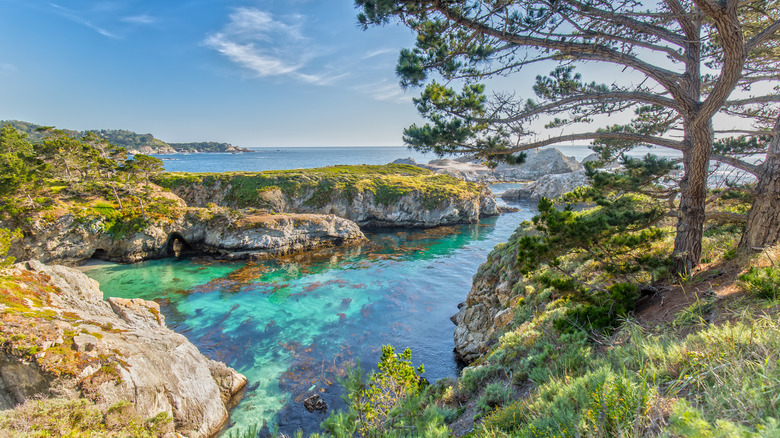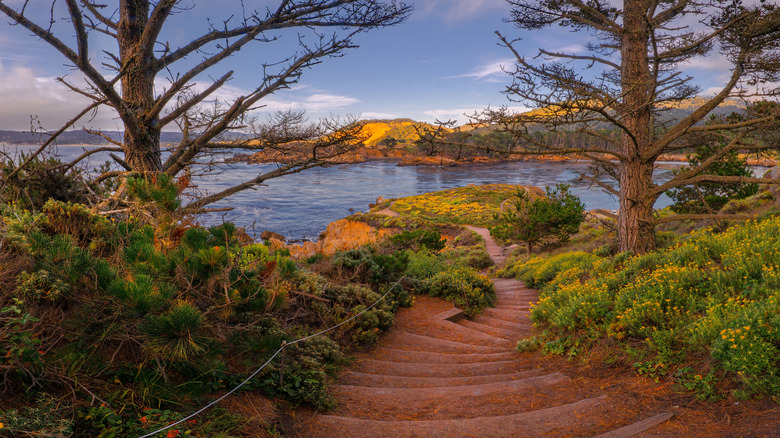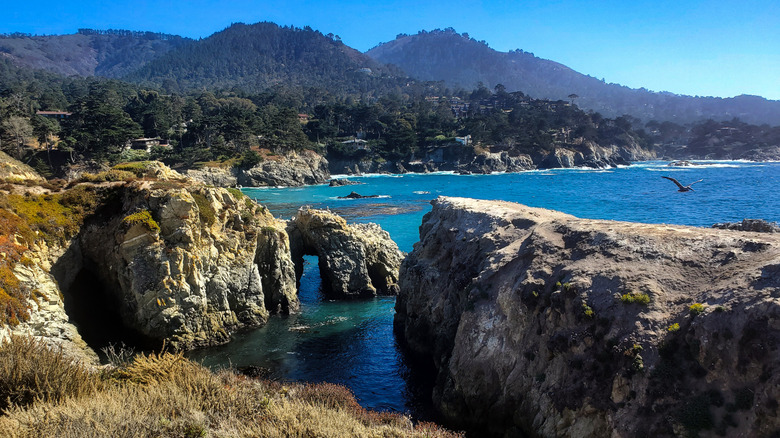The 'Crown Jewel Of The California State Park System' Has World-Class Trails, Scuba, And Wildlife Views
From Red Rock Canyon State Park with its sandstone cliffs to the towering trees of Humboldt Redwoods State Park, California has an abundance of incredibly beautiful state parks. But with all of that beauty, there is just one place known as "the crown jewel of the California State Park System," and that, per California State Parks, is Point Lobos State Natural Reserve. Another phrase used to describe it is "the greatest meeting of land and sea in the world." Said by prominent artist Francis McComas, who lived in Monterey around the turn of the 20th century, it really is an accurate description. Point Lobos does live up to all the hype.
It's on a small peninsula jutting out into the southern end of Carmel Bay, just north of Big Sur and about a 10-minute drive from Carmel-by-the-Sea. It's an absolute must-visit if you're on a road trip along California's famed Highway 1.
What's now a state natural reserve has a rich cultural history. It was used seasonally for over two thousand years by indigenous people. Then the Spanish used the area for cattle ranching in the late 1700s. In the mid-to-late-1800s, the area was used by whalers, who launched boats from what is now called Whalers Cove to harpoon gray whales. The wooden Whalers Cabin, with whale vertebrae supports in places, was built by Chinese fishermen in the 1850s and is still standing today. It's now a small museum with exhibits on the area's history.
Hiking at Point Lobos, keep an eye out for wildlife
There are about 10 total miles of trails at Point Lobos State Natural Reserve. A popular choice is combining trails to hike all the way around the peninsula. From Whalers Cove in the north to China Cove and Pelican Point in the south, that gives you a chance to see some of the most beautiful areas of the park (though pretty much everywhere is gorgeous); it's about 4.5 to 5 miles depending on exactly which way you go. You can skip part of the coast and get in a bit more of a workout by going up and over Whalers Knoll. Even if you don't hike around the whole park, one beloved trail is the Cypress Grove Trail, an easy hike with amazing ocean views. It takes you through an impressive grove of Monterey cypress trees; the only other native stand of these trees on the planet is in Pebble Beach.
Though Lobos means "wolf," there are no wolves here, though there are sometimes mountain lions and coyotes. Instead, the name comes from the Spanish, who came to the area and called it the "Punta de los Lobos Marinos," which was a reference to the sea wolves, or sea lions who live there. You may be able to see (and hear) some of those namesake creatures from Sea Lion Point Trail. On the west side of the peninsula, this 0.4-mile wheelchair-accessible trail takes you to a beach overlook.
Sea lions can be spotted at Point Lobos year-round, as can harbor seals and sea otters. Gray whales pass by each winter. There are also lots of birds, including brown pelicans, cormorants, and woodpeckers.
Scuba diving at Point Lobos and essential info for your visit
Point Lobos is a fantastic place for scuba diving and snorkeling right from the shore. Only Whalers Cove and Bluefish Cove are open for snorkeling and scuba diving, and you'll need to reserve ahead of time. There are a limited number of permits available each day. Another thing to keep in mind is that the water is cold! Expect it to be around 50 degrees Fahrenheit throughout the year, and plan your gear accordingly.
Some insider tips for your Point Lobos adventure: Always stay on the trail, and not just for the preservation of the park. There is poison oak scattered about, so consider wearing long pants. If you have a California state park pass, you can park inside. Otherwise, it's a $10 entrance fee. Arrive as early as you can. It's open from 8 a.m. to 7 p.m., and the parking lots will fill up, particularly on summer weekends. You can park for free along the highway and walk into the park. Just make sure to obey any posted signs for your safety and that of others. There are bathrooms and places to fill up water bottles, but no food or water is available for purchase. There is no camping, but there are plenty of places to stay in nearby Carmel and Monterey.
It's less than 10 miles from the Monterey Regional Airport, and it's about 1.5 hours from the San Jose Mineta International Airport. While you're in the area, you should definitely stop by the Monterey Bay Aquarium, one of America's best aquariums with world-class exhibits. You could also continue south along Highway 1 and make your way into the heart of Big Sur.


